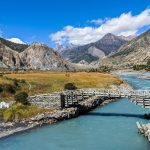Overview
Among the four seasons in Nepal, autumn and spring are the best times for the Annapurna Circuit trek. But it is also possible to trek the region in winter and monsoon with some preparation.
Autumn promises stable weather and brilliant clarity, while spring brings life and color to the hillsides. Winter is for those who seek a quieter experience. Even the monsoon or summer months are suitable for the greener and wilder beauty they present to you.
Time can define the kind of journey you have on the Annapurna Circuit. The same trail that feels peaceful and snow-covered in winter can transform into a vibrant and flower-filled path in spring or a crisp, festival-filled route in autumn.
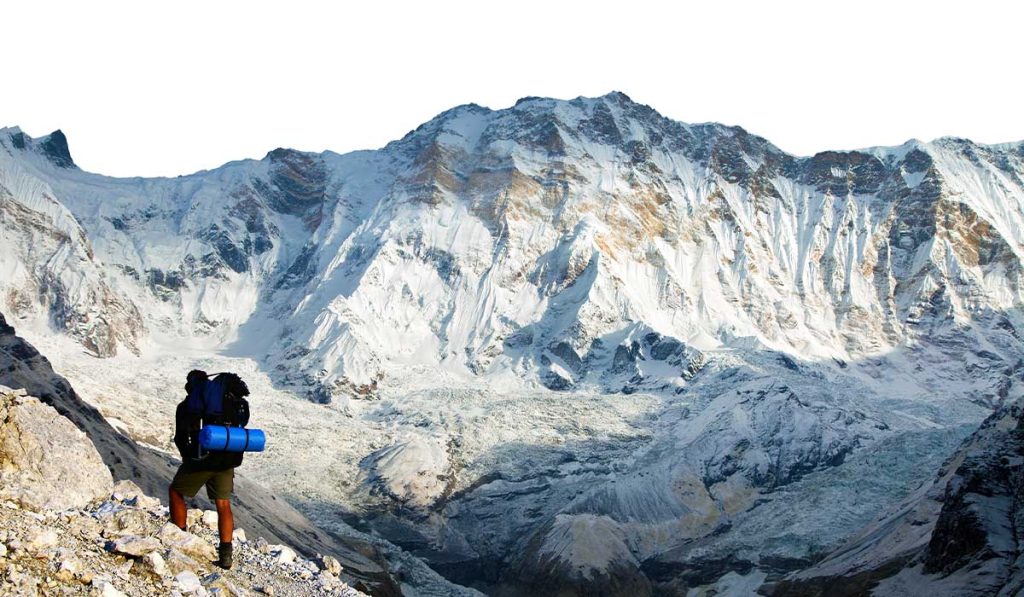
Stretching across central Nepal, the Annapurna Circuit is a diverse trekking route in the Himalayas. It circles the Annapurna massif, taking trekkers from lush green valleys and rice terraces to the windswept highlands beyond Thorong La Pass at 5,416 meters.
Because it spans several climate zones and altitudes, timing your trek is more than a matter of convenience. It is the key to the experience itself. That is because the Himalayas are known for dramatic shifts in weather and landscape.
In addition, each season offers something distinct. Based on the time of your visit, you can see clear mountain views and forest blooms, experience cultural festivals or enjoy serene solitude. Even a few weeks’ difference can decide whether you are crossing dry and sunlit trails or navigating rain-soaked paths.
If you are not sure about the right time to be a part of this trek, choose when to go based on your preferences, priorities and sense of adventure. Decide the time as per your suitability or contact Radiant Treks for guidance.
Highlights
- October is the winner for perfect weather and views, but it’s packed and pricey
- Mid-November is ideal as it is still sunny, crowds are gone, and teahouses are half-empty
- Spring trek means witnessing blooming rhododendrons and fewer people than in autumn
- Monsoon is for green beauty, dirt-cheap lodges, but there are leeches, landslides and no views
- Winter is peaceful and silent, features sparkling snow, very cold nights — suitable only if you love proper cold
- Thorong La can close any day after mid-December and not suitable if you are on a tight schedule
- Permits cost the same year-round, but off-season teahouses can be cheaper
- Climate change is real — rhododendrons bloom earlier, monsoon starts sooner, so check forecasts
Do Geography and Altitude Affect Weather on the Annapurna Circuit?
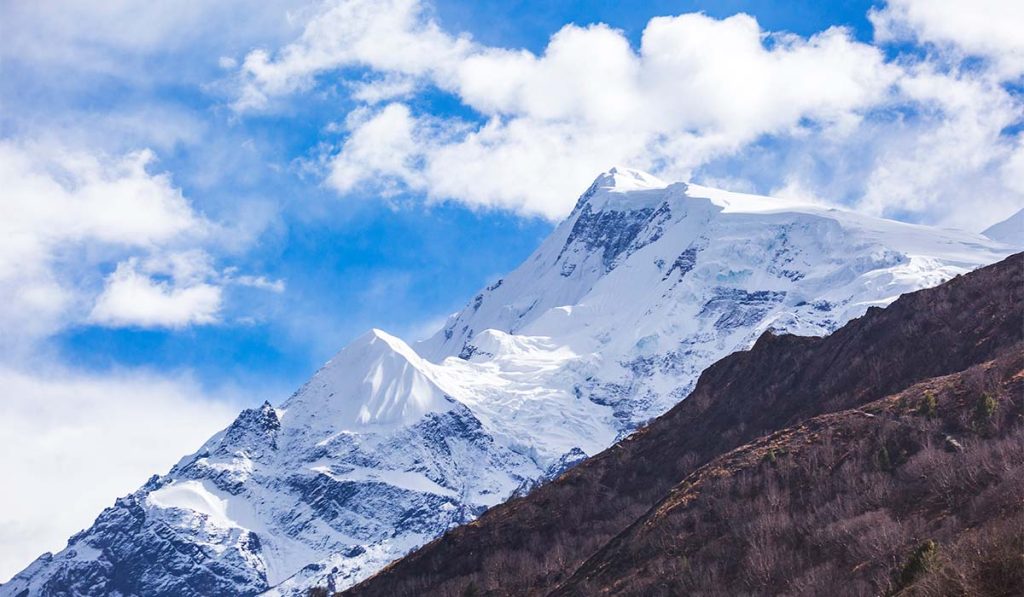
Yes, they can very much impact your Annapurna Circuit trek experience. It is trekkable almost year-round, but pick the wrong month and you will either be fighting chest-deep snow at Thorong La pass, drowning in monsoon rain and leeches, or facing crowds during October. The same trail that feels like a dreamy postcard in autumn can turn into a serious survival mission in winter or a cloudy adventure in July.
That’s why understanding the geography first is crucial before you pick your dates. In just 13 to 16 walking days, you go from lush, subtropical rice terraces around Dharapani, through pine forests and rhododendron blooms to Pisang and Manang. Then, you step into the dry rain-shadow world.
After crossing the 5,416 meters at Thorong La Pass, you drop into the windy, Tibetan-style high desert of Muktinath and Mustang. Thus, you trek from jungle to alpine to near-arid area in less than two weeks. No other trek on earth gives you that much contrast.
Nepal’s four distinct trekking seasons shape the entire experience: Spring (March to May) brings blooming rhododendrons and warmer days. Likewise, monsoon (June to August) turns everything green but rainy and risky. Autumn (September to November) delivers the clearest skies and best visibility. But winter (December to February) is known for solitude, snow and freezing temperatures.
So, choosing the right timing is more than a matter of weather. It is about the kind of experience you want. Ready to pick your perfect time? Radiant Treks offers the classic 13-day Annapurna Circuit trek and the extended 16-day version with Tilicho Lake. Drop us a message and we will help you decide the ideal dates for the experience you want.
Spring for Blooms, Blue Skies, and Brighter Days
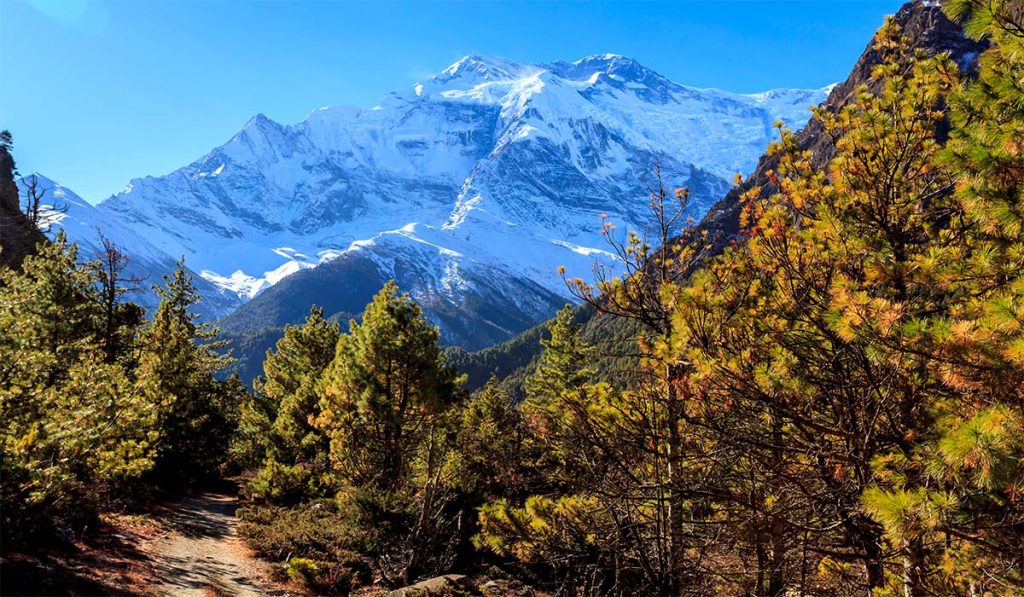
If you are finding it difficult to decide the best time for the Annapurna Circuit trek, then spring is one of the most popular seasons to be here. And that too for good reason. The arrival of spring means winter starts loosening its grip. As a result, the landscape in the Annapurna region bursts into color. It means you can see rhododendrons blooming across the hillsides. In addition, the days grow longer and warmer.
Weather Overview
From March through May, the weather is generally mild and stable in the Annapurna Circuit. The daytime temperatures hover between 15°C and 25°C in lower valleys, while at higher altitudes, nights can drop close to freezing. Snow remains on the high passes in early March but melts steadily by April. As a result, the Thorong La is more accessible in spring.
Why You’ll Love Spring
This season is ideal for trekkers as it offers clear skies and excellent mountain visibility. If you are a photography enthusiast, then you should choose to trek the Annapurna Circuit in spring.
Floral explosion is another attraction of March, April and May. The forests between Ghorepani and Manang are awash in pink and red rhododendrons, adding beauty to the trekking trail.
Meanwhile, you will find it comfortable to trek in spring as it is warm during the day. Meanwhile, the nights are cool, allowing for good sleep.
Moderate crowds are another highlight of the spring trek. Though this season is busier than winter, it is calmer than the autumn rush.
What to Watch Out For
There are many advantages of a spring trek, but you need to be careful of some aspects too. One thing you should know is that this is the pollen season. So, if you are prone to allergies, then you should carry antihistamines with you for your spring trek.
Dusty trails are another thing you should be prepared for. As temperatures rise, winds in Mustang and Manang can kick up dust, especially in late May.
Cultural Features
The spring Annapurna Circuit trek is for you if you want to immerse yourself in the cultural activities of the region. Holi, a March festival, allows you that opportunity. Known as the festival of colors, you can celebrate it with locals in Dharapani and other palces.
Buddha Jayanti, which can fall between April and May, means a chance to join the festive pilgrimage at Muktinath Temple. It is one of the holiest sites for Buddhists and Hindus alike.
Packing Essentials
Lightweight, quick-drying trekking pants, a UPF-rated sun shirt, a wide-brim hat, antihistamines for pollen and a compact umbrella for brief afternoon showers.
Best For
Spring is the best time for the Annapurna Circuit trek if you are a first-time trekker. It is also recommended for photographers who want a colorful, lively trail with balanced weather. In addition, those seeking to trek in peak season but with fewer crowds, then skip autumn and choose the spring trek.
Summer or Monsoon for Lush Landscapes, Fewer Crowds
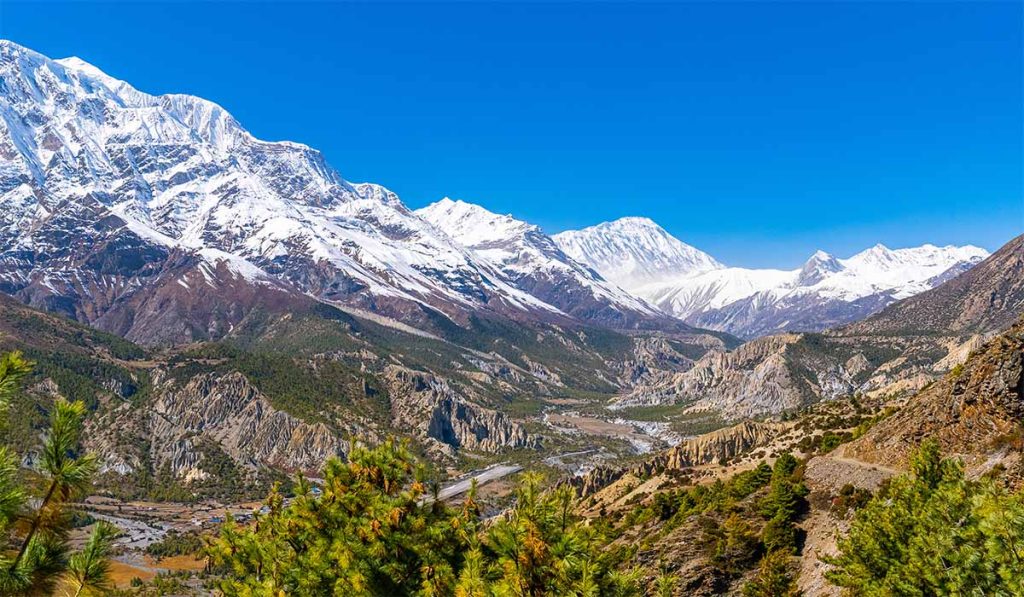
The monsoon season spans from June to August and brings warmth, rain and greenery on the Annapurna Circuit. This is not the most popular time. Yet it offers a unique side of the Himalayas.
Weather Overview
The Annapurna Circuit trail features warm and humid conditions in the monsoon or summer season. And this is true especially in the lower valleys. You can expect frequent rainfall, especially below 3,000 meters. The summer daytime temperatures range between 20°C and 30°C. The higher altitudes, like Manang, remain cooler and surprisingly dry due to the rain shadow effect in the monsoon months. Likewise, Mustang and Nar Phu Valley receive far less rain. Thus, they are ideal for monsoon adventures.
Why You’ll Love It
If you want to trek along lush and dramatic landscapes featuring green forests and waterfalls thundering down cliffs, you should head to the Annapurna Circuit trek in the monsoon. In addition, you will have the mountains nearly to yourself. Likewise, the rates of teahouse and guide drop significantly, allowing for a budget trek. As a result, you can extend your adventure. This is the ideal time to explore destinations like Tilicho Lake.
What to Watch Out For
Monsoon means the chances of landslides and they can block the trail, forcing you to reroute or cancel the journey. Even if you do not face such a major natural disaster, slippery paths due to the rain can make the hike dangerous and also slow you down. Not to forget are the swollen rivers in the lower sections of the Annapurna Circuit.
In addition, leeches are common in forested areas. So, carry salt or spray to deter them. Along with that, you may get limited mountain views as cloud cover often obscures peaks until early morning.
Flight disruptions could be a hurdle for you if you want to travel by airplane upon your return. Though you need not worry about that with our itinerary, as it has road travel only.
Packing Essentials
A sturdy Gore-Tex rain jacket and pants, waterproof boots, several dry sacks (10L or more), salt packets for leech removal and a headlamp with red mode for dim and muddy paths.
Best For
This is the best time for the Annapurna Circuit trek if you are a seasoned trekker seeking solitude. Also, this is a golden time for those trekking in rain-shadow zones like Manang, Mustang or Nar Phu.
Autumn For Perfect Trekking Weather
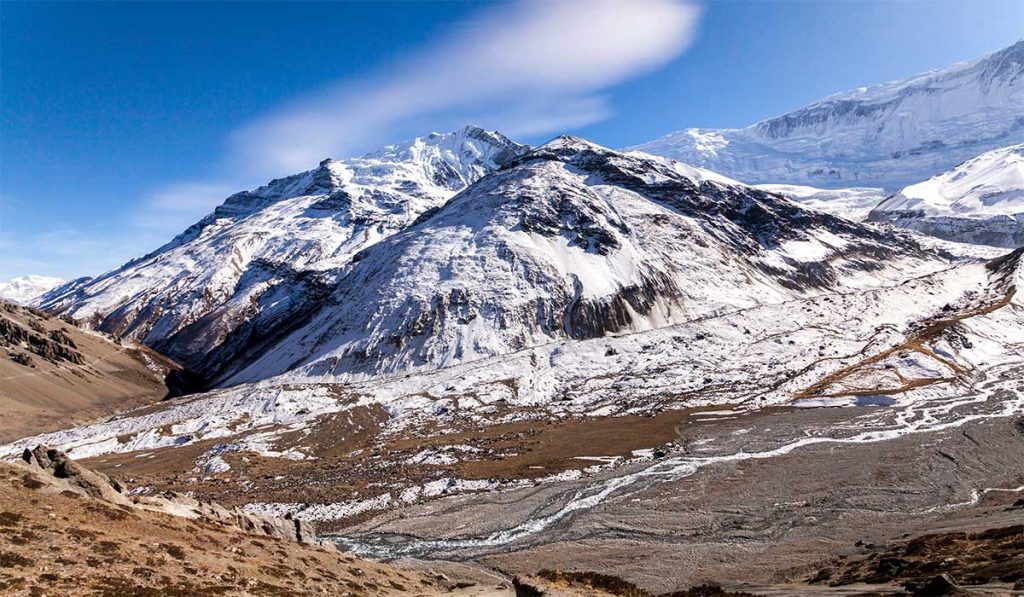
September, October and November are the autumn months in Nepal. They are widely regarded as the best time for the Annapurna Circuit Trek. One of the reasons is that the monsoon rains have cleared the dust from the skies with the arrival of autumn. Thus, the views are crystal clear. Ultimately, this allows for perfect trekking weather. After all, this is when the Himalayas reveal themselves in full grandeur.
Weather Overview
If you are in the Annapurna Circuit from mid-September onward, then you can see the skies turning brilliant blue. Temperatures stay pleasant in this season. They can be from 10°C to 20°C in mid-altitudes. But it can be slightly below freezing at higher camps. With most of the days clear, autumn promises the best visibility of the year for trekkers.
Why You’ll Love Autumn
Autumn is the most-preferred trekking season in Nepal as it offers the post-monsoon clarity. As a result, you can get the best views of mountains like Annapurna, Dhaulagiri and Tilicho Peak.
Stable condition of the trails is another reason. They are dry throughout the season. Add to that the crisp air and mild temperatures. All these factors together make walking a joy rather than a challenge.
Cultural immersion is also possible in autumn as villages come alive with harvests and celebrations. In addition, the logistics are reliable. It means the teahouses along the Annapurna Circuit remain open and the road conditions are also safer.
What to Watch Out For
While autumn trekking comes with many advantages, there are some factors to consider before choosing to trek in this season. The first is the crowded trails. October sees the highest number of trekkers. So, you need to book teahouses in advance. At the same time, accommodation and guide fees rise during this period.
Interestingly, you might need to line up for hours to show your trek permit as well. This is the case especially in October, as this is the most-trekked month not only of the autumn, but of the entire year.
Cultural Features
Autumn is the perfect time for trekking the Annapurna Circuit if you wish to explore the cultural facets of the region along with its natural beauty. Dashain, the biggest and most popular festival celebrated by Nepali Hindus, falls either in October or early November. You can see locals celebrating the festival with joy and festivities. But some lodges close briefly as locals visit family. However, booking helps in such cases.
A few weeks after Dashain is the festival of Tihar. It is known as the festival of lights and transforms Manang and other areas with flickering lamps and warm hospitality.
Packing Essentials
Merino wool base layers, a lightweight down jacket (800-fill), fleece mid-layer, glacier glasses and a wide-brim hat for high-altitude sun.
Best For
Autumn trek of Annapurna Circuit is for you if you are chasing the best weather, clearest skies and rich cultural experiences. It is ideal for first-timers as well as professional photographers alike.
Winter For Serenity, Snow and Starry Nights

Winter brings the quietest and most dramatic atmosphere to the Annapurna Circuit. The air is crystal clear in December, January and February. Likewise, snow-capped peaks glow in the sharp Himalayan sunlight. It is a rewarding time if you have prepared for the trek despite some challenges.
Weather Overview
Daytime temperatures stay around 10°C to 15°C in the lower valleys in the Annapurna Circuit in winter. They can drop to -15°C or colder near Thorong La Pass. Likewise, the trails above 4,000 meters often get snowed in by mid-January. However, early winter (December) usually remains accessible because of the warmer recent winters.
Why You’ll Love It
Winter trekking of the Annapurna Circuit is for you if you love peace and solitude. With very few trekkers on the trail, you will have entire stretches of the path to yourself most of the time.
In addition, the winter Annapurna Circuit trek means a chance to experience spectacular visibility. The dry air provides unmatched mountain clarity.
Meanwhile, this journey can be a budget-friendly affair, too. The rate of teahouses usually goes down in winter on the trekking trail as there is no competition for the rooms.
What to Watch Out For
Winter means snowfall. Thus, there is a chance of the trail being closed due to it. That is true in the case of Thorong La Pass. It may be impassable after mid-January.
Also, you need to be ready to brave extreme cold as winter on the Annapurna Circuit often comes with subzero nights and frost-covered trails. Yet, it is possible to beat the challenges if you trek with proper gear.
Short daylight hours can also be a hurdle. With the sun setting early and rising late, you need to plan for shorter walking days. Also, it is essential to start early to reach the destination before the sun sets, making the walk difficult.
Cultural Features
You get a chance to witness and participate in the Lhosar festival celebration in the Annapurna circuit in winter. This is the Tibetan New Year, celebrated in Manang and Mustang with mask dances and monastery feasts, usually in the month of February.
Packing Essentials
A -20°C-rated four-season sleeping bag, microspikes or light crampons, chemical hand warmers, insulated bottle sleeves, and a heavy down jacket.
Best For
Though not the best time for the Annapurna Circuit trek, you can be here in winter if you are an experienced trekker. Also, it is best for those who are comfortable with cold, solitude and occasional snow crossings. If you are ready to brace the winter challenges, you are sure to witness the Annapurna range in its quiet and pristine winter form.
Permits and Seasonal Booking Scene

Every foreign traveler must obtain the Annapurna Conservation Area Permit to be able to trek the Annapurna Circuit. The permit fees remain fixed throughout the year. It does not matter what time of the year you visit this region.
However, the experience of securing and using them varies with the season. During peak months, that is, autumn’s October and November as well as spring’s April and May, the checkpoints are quite crowded. You might need to wait in line to show your permit due to the heavy footfall of trekkers.
In contrast, trekking during quieter months means faster processing and cheaper accommodation. The rates of the teahouse tend to drop, and you get a good bargain.
Altitude Sickness Prevention by Season
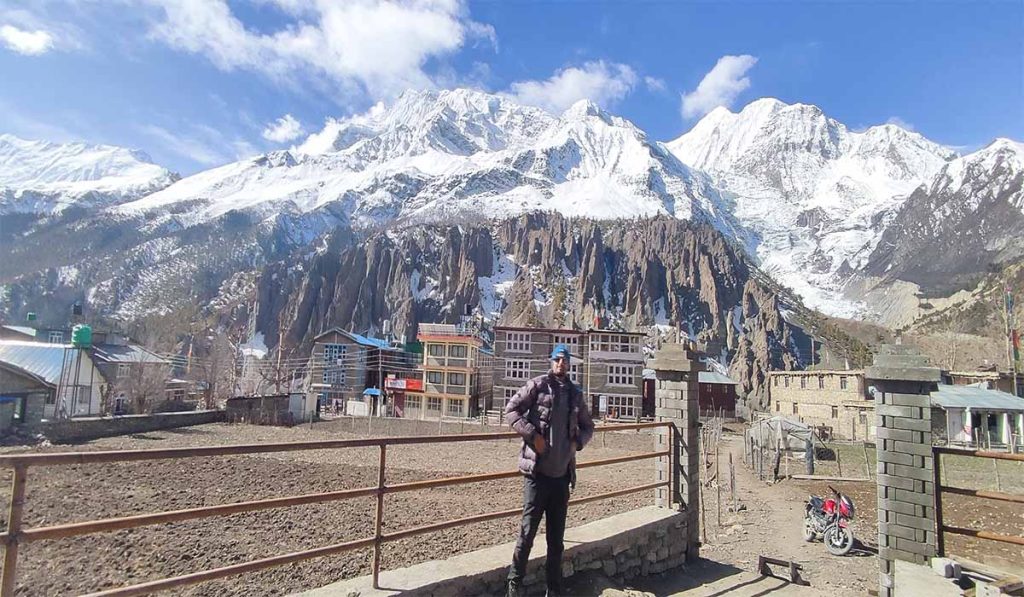
No matter the time of year, altitude sickness remains the biggest challenge on the Annapurna Circuit trek. The safest way to adapt while on the trek is to take it slow and schedule an extra acclimatization day in Manang. It is a vital stop for adjusting to the thin air before crossing Thorong La Pass.
Doctors often recommend starting Diamox about 24 hours before reaching 3,500 meters to help the body adjust. You can do so, but consult with your physician in advance.
Hydration is equally important while on any trek, including the Annapurna Circuit trek. The dry winter months demand more water intake, and thus, trekkers should increase it by around 30 percent.
The problem of dehydration exists even in summer. Its humid air can cause dehydration through sweat. Thus, steady fluid intake is still of great value. However, avoid drinking alcohol. Listen to your body and pace yourself. These small precautions ensure a safer and more enjoyable trek across all seasons.
Changing Weather Pattern and Their Effect on Trek Planning
The planning of the Annapurna Circuit trek is increasingly unpredictable because of the changing pattern of weather and its dramatic shifts in the mountains. Erratic rainfall, shifting monsoon schedules and rising temperatures are altering the traditional trekking calendar. Eventually, this is affecting when and how it is safe to journey through the region.
According to ICIMOD’s report titled Hindu Kush Himalaya (HKH) Monsoon Outlook 2025 and related climate reports, the Annapurna Circuit has seen increasingly erratic rainfall patterns. Some areas receive heavier and earlier season rains. But other areas of the region are experiencing delayed withdrawal of the monsoon.
It means the rising temperatures are shifting the natural rhythm of the Himalayas in Nepal. Rhododendrons now bloom earlier. Winters are also becoming noticeably warmer in recent years. These changes can affect trail stability, visibility along with travel safety.
To deal with such impacts, you should rely on updated local forecasts and climate bulletins when choosing the best time to trek Annapurna Circuit.
Common Timing Mistakes During the Annapurna Circuit Trek
- If you are traveling to Pokhara by flight, then never book tight flights in the monsoon without 2 extra nights in Pokhara. Cancellations are brutal.
- Winter is way colder than Instagram shows. So, rent proper gear in Thamel, or you’ll freeze.
- Trekking during Dashain week means empty ATMs and very few public vehicles available. Withdraw cash early to avoid hassle.
- The conditions of roads and weather change every year. So, stay updated about the current situation.
- Get travel insurance that actually covers 6,000 m evacuation.
- Cotton is not useful at higher elevations; wear only synthetics or wool.
- Don’t trek solo in monsoon as landslides and leeches are a real danger — hire a guide.
FAQS
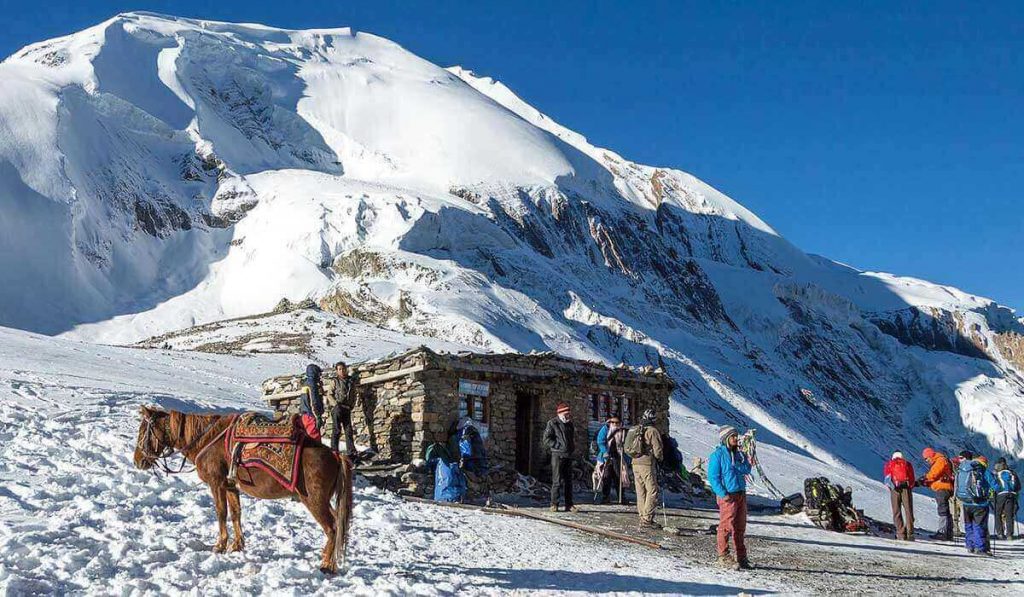
What’s truly the best month for the Annapurna Circuit trek?
October, without doubt, is the best time of the year. This month is known for stable weather, almost zero rain and clear views of the big peaks. It’s crowded and expensive, but that’s the price for perfection.
Can a beginner do the Annapurna Circuit trek in in monsoon?
The beginners should not try the adventure at this time of the year. Monsoon means daily rain, landslides, leeches, zero views, flights cancelled and blocked roads. Even experienced trekkers think twice before being a part of the monsoon Annapurna Circuit trek.
How cold does Thorong La Pass get in December?
Daytime temperatures are between –8°C and –12 °C. At night, they can range from –18°C to –25 °C with wind chill.
Are permits cheaper off-season?
No, the Annapurna Conservation Area Permit fee stays the same year-round. The real savings are in teahouses and porters, especially in winter or monsoon.
Which is the best time for the Annapurna Circuit trek if I hate crowds?
The second half of November or the first half of March is the best time without crowds. The weather is still excellent, but the trail suddenly feels empty.
Do I opt for the spring or autumn Annapurna Circuit trek for the clearest views?
Autumn wins easily with 95 percent blue-sky days as compared to spring’s 80–85 percent. The spring may sometimes miss offering clear views because of pre-monsoon haze.
Is it possible to opt for eco-friendly trekking while choosing the right season?
Absolutely. To minimize your carbon footprint, travel off-peak season. The trails are quieter and accommodations are less crowded during this time. Carry reusable water bottles or filters and avoid packaged snacks.






